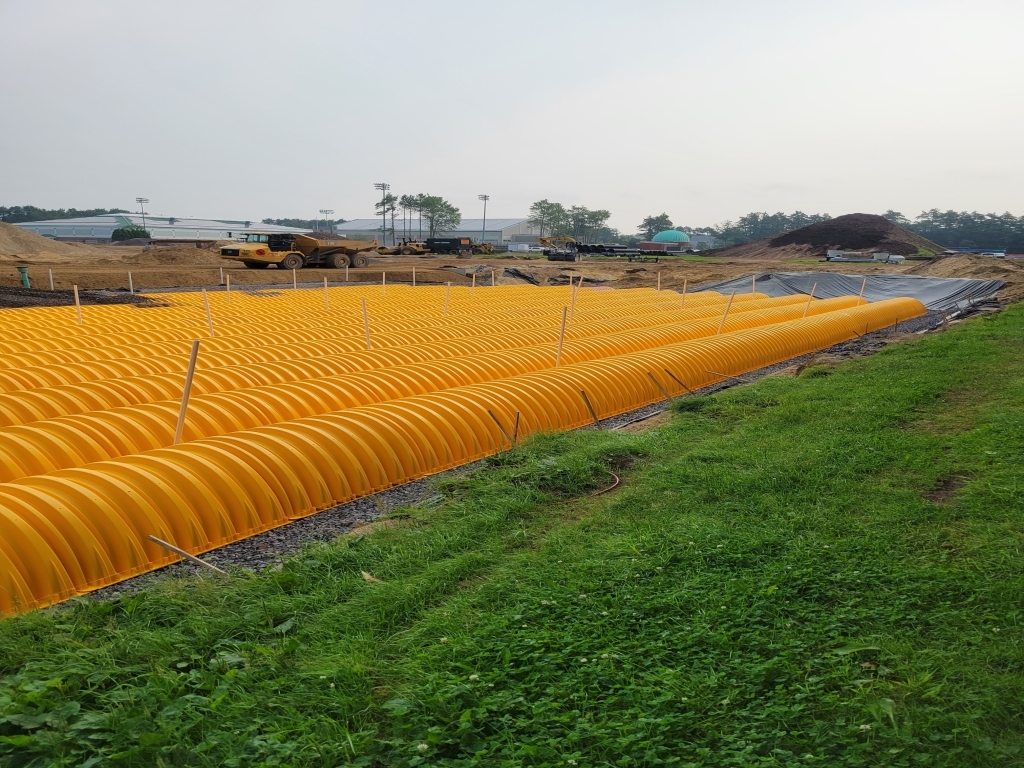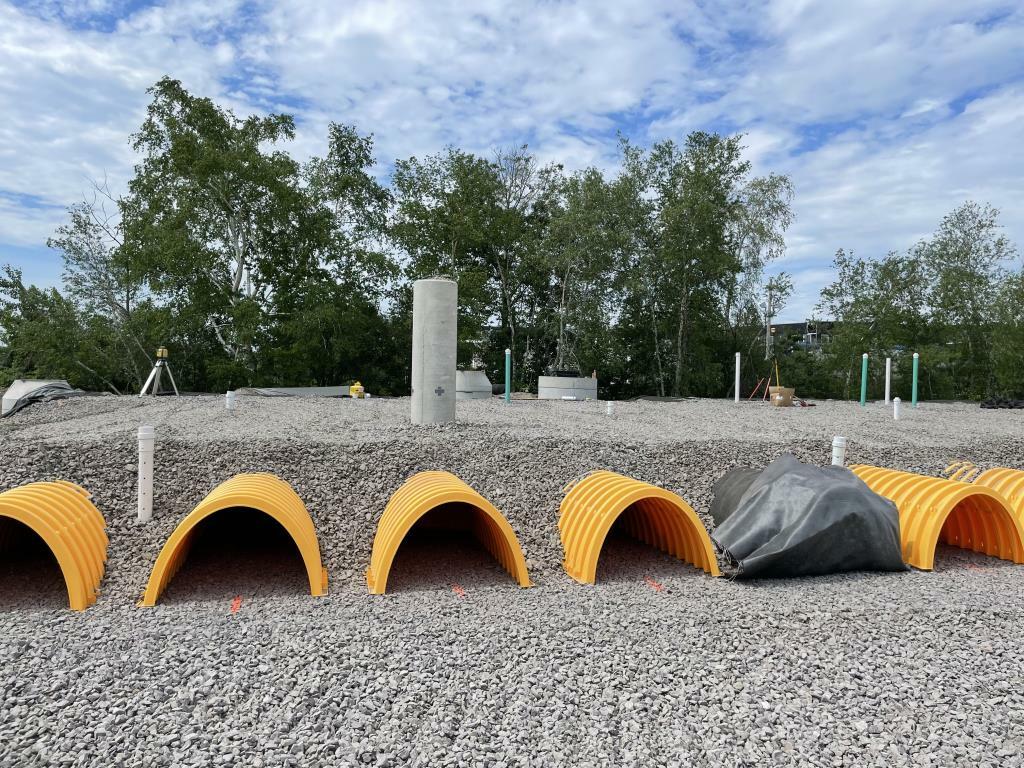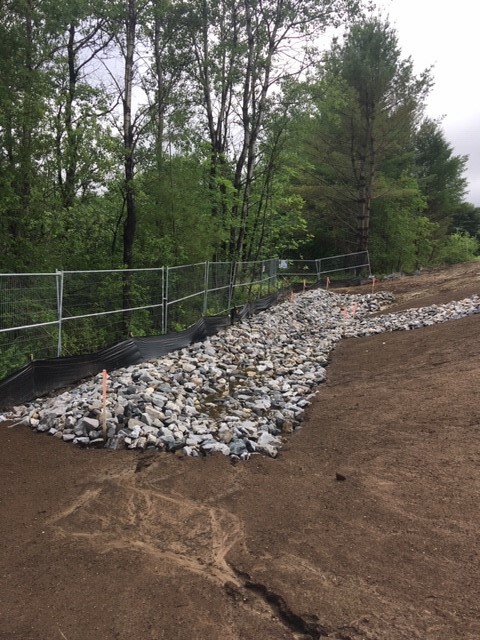Stormwater management is a critical aspect of land development, particularly on small and constrained sites. These sites often pose unique challenges due to limited space, flat topography, or the presence of wetlands. Traditional stormwater systems, such as a network of catch basins, may not be feasible in such situations. Sebago Technics offers innovative solutions for stormwater management plans in constrained sites. With our expertise in media filters, storage chambers, level spreaders, and more, we provide effective stormwater treatment options for even the most challenging projects. Keep reading for some of the challenges faced and how we overcome them.
Challenges of Constrained Sites
Constrained sites present several challenges when it comes to stormwater management. Firstly, limited space restricts the installation of conventional stormwater infrastructure. On small sites, there may not be sufficient room for large detention ponds or extensive drainage networks. Additionally, flat sites with wetlands further exacerbate the constraints, as vertical limitations come into play. Traditional stormwater systems require a significant drop in elevation from the inlet to the outlet, which may not be achievable on these sites. Therefore, alternative solutions are necessary to effectively manage stormwater in such environments.
Sebago Technics’ Innovative Approach
Sebago Technics specializes in developing innovative stormwater solutions tailored to the specific needs of constrained sites. Our expertise lies in utilizing various techniques and systems to effectively treat stormwater, ensuring compliance with regulations and minimizing environmental impact.
Filters
Filters are an essential component of stormwater management plans. Sebago Technics utilizes advanced filtration systems that capture pollutants and sediments from stormwater runoff. These filters prevent harmful substances from entering bodies of water, thus protecting the ecosystem and promoting water quality. By incorporating filters into stormwater management plans, Sebago Technics ensures that even on constrained sites, effective treatment measures are in place.
Storage Chambers
To overcome limitations in space, Sebago Technics utilizes storage chambers as part of its stormwater management strategy. These underground structures provide temporary storage for excess stormwater runoff, preventing flooding and reducing the strain on existing drainage systems. By utilizing the vertical space efficiently, storage chambers allow for effective stormwater management without compromising the site’s limited surface area.
Permeable Surfaces
The major advantages of permeable surfaces are that stormwater treatment occurs within the development footprint and they require less drop in elevation than underground storage chambers. Permeable surfaces are an effective stormwater solution on constrained flat sites. Several different types of permeable surfaces can be utilized to meet the project goals including porous asphalt, concrete, and pavers. Permeable surfaces require a higher level of maintenance than other treatment devices. Sebago Technics works with you to develop a maintenance program to ensure that the system functions properly and to extend the life of the system.
Level Spreaders/Vegetated Buffers
Level spreaders and vegetated buffers are another innovative solution utilized by Sebago Technics to handle stormwater runoff on constrained sites. Runoff is directed to a level spreader, which is used to dissipate channelized flow before conveying it across a vegetated buffer downstream. Vegetated buffers can consist of meadow or forested land cover. Level spreaders can be designed with additional volume to detain runoff, if needed. The vegetated buffer downstream provides treatment of runoff, including the natural removal of pollutants, phosphorus, and sediment, prior to discharge in downstream drainageways. Level spreaders/buffers help prevent erosion, promote groundwater recharge, and improve water quality. These systems are generally designed to utilize the undeveloped area of a project space, rather than a traditionally designed Best Management Practice (BMP), which results in greater disturbed area.
Successful Case Studies from Sebago Technics
Bowdoin College Athletic Fields
The general project programming consisted of (3) artificial turf fields and (2) natural grass fields. Bowdoin College has an existing Maine DEP SLODA Permit, which required the new project to meet Maine DEP treatment requirements. The project is located within the Mare Brook Watershed, an Urban Impaired Stream, which requires the project to treat the new development to a specific standard and potentially offset any new development by treating or mitigating existing areas contributing to the impaired watershed. The artificial turf fields were treated in place by a sand filter layer underneath the surface of the field, while the remaining new development was treated by a subsurface sand filter chamber system. The chamber system was sized to treat an existing area to the northeast of the fields that were initially not receiving treatment on the campus. The subsurface system allowed Sebago Technics and Bowdoin College to mitigate the overall impact to the site that a surface BMP would require, as all the storage and treatment happens underneath any grassed fields or playing fields and didn’t require any additional tree clearing for an above ground system. The system was able to capture & treat more than was required by the Urban Impaired Stream Standard, which would further improve the quality of life of the watershed.

218 Washington Avenue, Portland, Maine
The 218 Washington Avenue condominium project in Portland was a unique site in that the elevation changes on the site restricted where a stormwater system could be placed. A subsurface sand filter below a plastic chamber system was utilized to allow for the maximum development feasible on the property. By locating the stormwater below the surface, the parking and condominium building could be placed above the system and within the same overall site development footprint. This did not come without challenges as the system had to be designed to navigate around structural components such as foundation wall footings and column footings from the above parking garage. In addition, the system was designed to not impact the geogrid layout which supported the retaining wall and overall global stability of the structure. The design was not only a success and best use for the site, but also a great exercise in coordinating with multiple engineering firms on their respective designs.

Lewiston Fire Sub-Station
The Lewiston Fire Sub-Station was constructed in 2020 on North Temple Street in Lewiston, Maine. The site design included a 9,130-square-foot building, paved driveways and parking, pedestrian walkways, and utilities to serve the project. The improvements resulted in less than one acre of impervious area, however, treatment and detention of stormwater were required for local permitting. Due to the wide turning radius of the fire apparatus, adequate space was needed on-site to accommodate the maneuverability of emergency vehicles. As such, a detention basin was used for stormwater attenuation and a wooded buffer was proposed downstream for treatment of runoff. The site was a good candidate for utilization of a level-lip spreader and wooded buffer, as the soils in these areas were non-hydric and on-site topography was not steep. Treatment of runoff was achieved with a non-invasive, natural buffer; no disturbance to the downstream wetland occurred, saving space for necessary paved areas and keeping the overall development footprint to a minimum.

Contact the Stormwater Management Professionals at Sebago Technics
Innovative stormwater management plans and solutions are essential for addressing the unique challenges posed by constrained sites. Sebago Technics’ expertise in utilizing filters, storage chambers, level spreaders, and other innovative techniques allows for the effective treatment of stormwater in small and complex environments. By offering tailored solutions, we ensure compliance with regulations, protect the environment, and promote sustainable land development practices. Whether it’s limited space or vertical constraints, our team provides innovative stormwater solutions for every project, enabling the successful management of stormwater in constrained sites.
To learn more about Sebago Technics’ innovative stormwater solutions, contact us to chat with Sebago Technics today!

